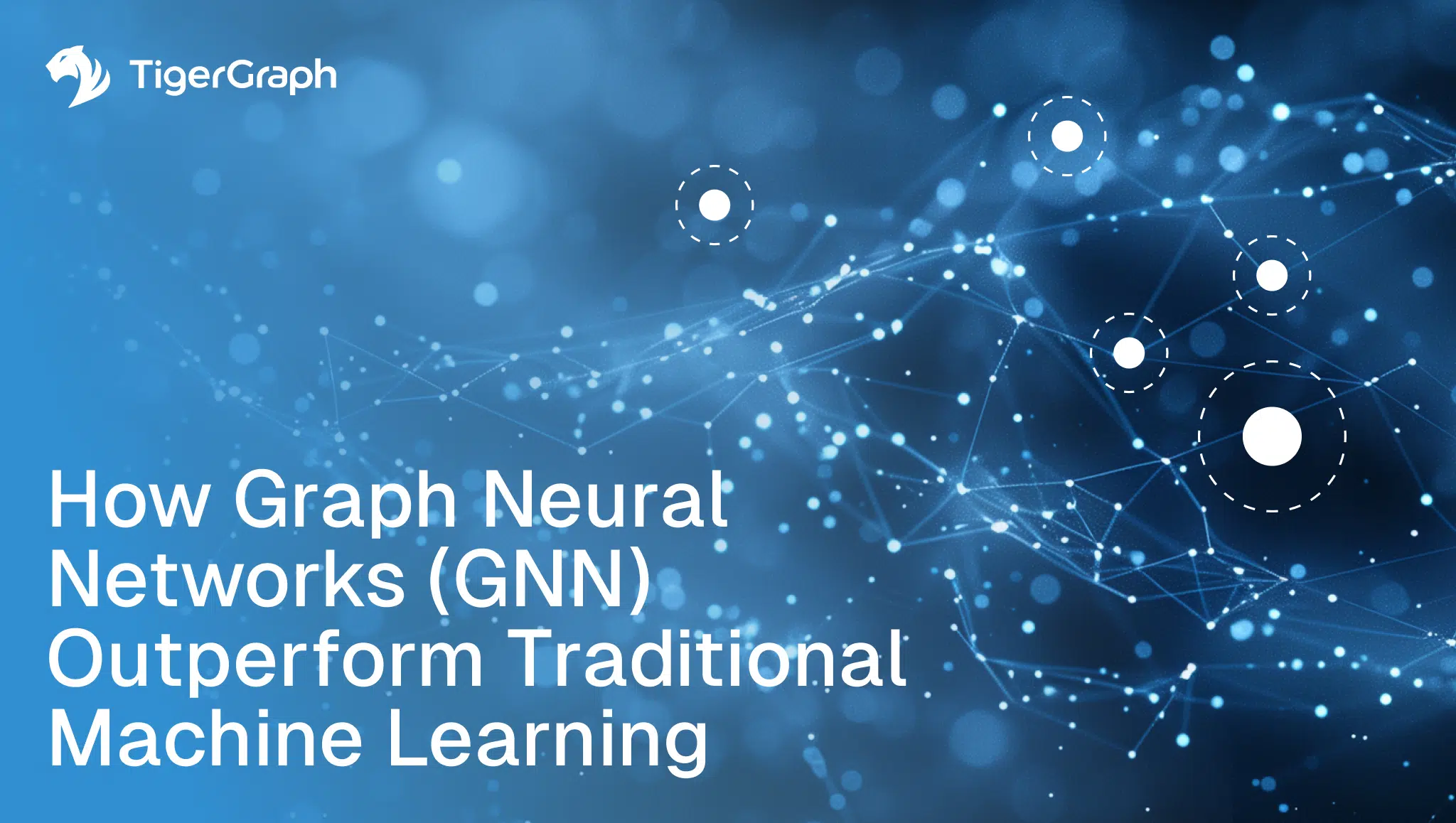How Graph Neural Networks (GNN) Outperform Traditional Machine Learning
Traditional machine learning can tell you a lot, but not everything, and especially not when the relationships between your data points are where the real intelligence lives. And this is a big problem.
Graph Neural Networks (GNNs) fundamentally change how we think about machine learning by embedding relationships and context directly into the learning process. When fueled by TigerGraph’s high-performance graph technology, GNNs enable a new class of smarter, more trustworthy AI applications.
This is why context matters—and why TigerGraph is the critical foundation for scaling GNN-powered intelligence.
The Tabular Trap: What Traditional Machine Learning Misses
In a conventional machine learning pipeline, data is flattened into rows and columns. Every entity (a person, a transaction, a device) is treated independently. Even when relationships matter, they are often awkwardly “engineered” via feature creation, which is a brittle and manual process.
Not only is it inefficient, it creates blind spots:
- Missed connections between related fraudsters who hide across accounts. These hidden relationships go undetected because traditional models only analyze isolated features—never the paths between them. TigerGraph’s real-time traversal surfaces these hidden paths, exposing coordinated fraud rings and linked account activity.
- Inability to detect collusion across complex supply chains. When multiple suppliers are connected through indirect partnerships, traditional models can’t see the full chain of influence, leading to blind spots. TigerGraph’s multi-hop analysis uncovers these paths in milliseconds.
- Lost opportunities to predict outcomes influenced by network effects, like cyberattacks or social behaviors. Graph analytics allow for multi-hop pathfinding that can surface these hidden influences in real time.
In essence, traditional ML sees dots, not the lines connecting them. It can see the trees, but not the forest.
GNNs Learn from Relationships
Graph Neural Networks fix this fundamental flaw, as they don’t just analyze isolated features—they learn from the structure of the graph itself:
- Each node (entity) updates its understanding based on the features of its neighbors. This means that when one node in a fraud ring acts suspiciously, connected accounts can also be flagged for further inspection.
- Patterns emerge not just from what an entity is, but who and what it is connected to. By understanding connections, GNNs can surface hidden players in complex networks—something traditional ML misses entirely.
- Like convolutional neural networks (CNNs) for images, GNNs “convolve” across neighborhoods, making local context central to the learning process. Remember, convolving is the process where GNNs learn from their neighbors, aggregating information layer by layer to uncover hidden patterns across connected nodes. [link to last post]
This is critical for real-world applications where relationships are the signal:
- In fraud detection, knowing how accounts, devices, and transactions cluster reveals hidden risks. For example, GNNs can reveal orchestrated fraud rings that would be invisible to isolated attribute analysis.
- In cybersecurity, tracing how entities interact can highlight lateral movement and stealth attacks. Multi-hop traversal enables GNNs to detect threat patterns that evade traditional monitoring.
- In personalized recommendations, understanding shared interests among friends or peers can dramatically improve targeting. GNNs understand not just individual behavior but community-driven interests.
Leveling Up with Hybrid Graph + Vector Search
TigerGraph’s Hybrid Graph + Vector Search, further extends this capability by combining two powerful methods:
- Graph Search surfaces hidden patterns and multi-hop relationships that reveal anomalies—complex, network-wide irregularities that traditional ML often misses.
- Vector Search finds what’s most similar—identifying closely matched patterns across high-dimensional data to support accurate predictions, recommendations, and behavioral modeling. It can also flag outliers by highlighting what doesn’t fit.
The distinction between anomalies and outliers is critical:
- Outliers: Deviations from the typical but which are ordinary statistical variations.
- Anomalies: Structurally significant deviations that represent meaningful insights or threats, such as hidden fraud rings or network vulnerabilities.
TigerGraph’s advantage lies in real-time, hybrid querying that bridges both methods, uncovering hidden threats and structural weaknesses faster than traditional models can process.
Traditional Databases Can’t Handle Multi-Hop Relationships
Traditional SQL databases are optimized for transactional data, which involves individual records linked by foreign keys. To analyze relationships, they rely on joins across multiple tables, which become increasingly slow and costly as the relationships become more complex. For example, tracing a money-laundering path across five banks and dozens of accounts could require nested joins that significantly slow down processing.
NoSQL solutions, while optimized for speed, prioritize document storage over relationships. They do not natively support multi-hop traversals and require complex application logic to reconstruct paths.
TigerGraph is purpose-built for multi-hop queries. Its native graph storage allows edges (relationships) to be traversed directly and instantly, even over billions of nodes.
The Foundation for Real-World GNN Success
Running GNNs at scale isn’t just about algorithms. It’s about having the right data foundation. And that’s where TigerGraph uniquely excels:
- True Graph-Native Architecture: Stores and traverses connections natively—no costly joins or manual pre-computations required.
- Massive Parallelism: Deep parallel traversal engine enables real-time access to billions of connections, making it feasible to run GNN pipelines over enterprise-sized graphs.
- Rich Feature Engineering: Enables teams to efficiently extract graph features (such as centrality scores, community memberships, or shortest paths), to enrich the features used to train the model, both for GNNs as well as other models.
- ML Integration: Through TigerGraph ML Workbench, teams can seamlessly generate graph features, embeddings, and neighborhoods, then feed them in real time for GNN model training using modern AI frameworks.
Context Is the Competitive Edge
Without context, machine learning misses the forest for the trees. With TigerGraph and GNNs, you see not just the dots but the powerful, meaningful patterns connecting them.
As I’ve shared in recent presentations, real-world intelligence isn’t flat. It’s relational. To achieve smarter AI, you need a more intelligent foundation.
TigerGraph enables context-rich, graph-powered AI that is scalable, real-time, and enterprise-ready. Reach out to learn more about what it can reveal for you today!

